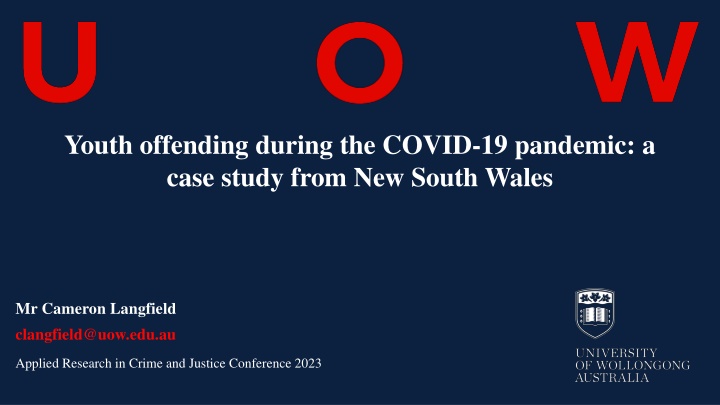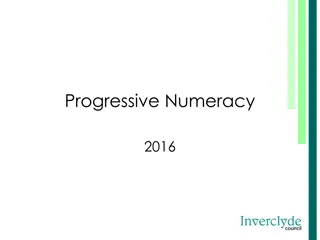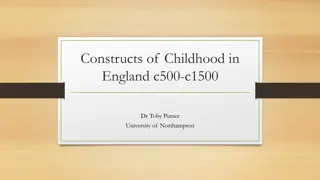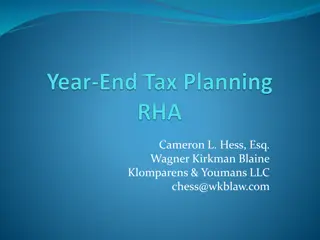
Impact of COVID-19 on Youth Offending Patterns: A Case Study from New South Wales
Explore the impact of the COVID-19 pandemic on youth offending in New South Wales through a case study. Discover how property crimes declined while domestic violence and drug offenses increased. Uncover insights from research studies on changes in youth crime rates during the pandemic.
Download Presentation

Please find below an Image/Link to download the presentation.
The content on the website is provided AS IS for your information and personal use only. It may not be sold, licensed, or shared on other websites without obtaining consent from the author. If you encounter any issues during the download, it is possible that the publisher has removed the file from their server.
You are allowed to download the files provided on this website for personal or commercial use, subject to the condition that they are used lawfully. All files are the property of their respective owners.
The content on the website is provided AS IS for your information and personal use only. It may not be sold, licensed, or shared on other websites without obtaining consent from the author.
E N D
Presentation Transcript
Youth offending during the COVID-19 pandemic: a case study from New South Wales Mr Cameron Langfield clangfield@uow.edu.au Applied Research in Crime and Justice Conference 2023
Property crime, including break and enter, declined (Ashby, 2020a, 2020b, Boman & Gallupe, 2020) Motor vehicle theft and theft from motor vehicles down (Ashby 2020a) Property crime declined by 37% (Boman and Gallupe, 2021) Domestic violence increased (Piquero et al. 2021) EUROPE ASIA NORTH AMERICA In the UK, crime declined by 41 percent (Halford et al. 2020), with the largest declines seen in shoplifting and theft Crimes declined during the first month of lockdown in U.K. but quickly returned to normal once lockdown ended (Langton et al. 2021) Gerell and colleagues (2020) showed total crime in Sweden declined, with the largest declines in assault, pickpocketing, and burglary Similar results were obtained in the Netherlands (Noolenaar & Choenni, 2021) Borrion and colleagues (2020) showed retail theft declined during the COVID-19 lockdown in one Chinese city (by almost 64 percent) Chen and colleagues (2021) showed further declines, though documented an increase in cyber-crime AUSTRALIA Queensland analysis show marked declines in common, serious and sexual assault (Payne et al. 2020) Property crimes (residential burglary, shop theft, and fraud) also declined (Andresen & Hodgkinson, 2020; Payne et al. 2021) Drug offences increased (Langfield et al. 2021; Payne & Langfield, 2021, 2022) New South Wales crime declined (Kim & Leung, 2020; Wang et al., 2020)
Impact of COVID on Youth Crime Reid and colleagues (2021) Baglivio and colleagues (2022) Revital and Haviv (2022) McCarthy and colleagues (2021) Increases in both psychological distress and antisocial behaviour after the COVID-19 lockdown Significant decline in juvenile domestic violence referrals after schools in Florida had closed Found that juvenile assault rates experienced a significant decline during the lockdown Declines in youth property offending, declines in offences against the person, and public order offences 1 2 3 4
The current study Here we use officially recorded unit-record offence data drawn from the Reoffending Database (ROD) to document to what extent the pandemic has affected youth offending patterns Specifically, these data are for those individuals recorded in ROD as having a birth year of 2004 This cohort was selected before they were entering a period of late-adolescence (i.e., turning 16 years of age) as COVID-19 restrictions were first introduced in March 2020 To enable comparison and in the absence of a true control group we have also extracted unit-record data for those individuals recorded in ROD as having a birth year of 2002 and/or 2000
2004 Cohort Age 10 Age 11 Age 12 Age 13 Age 14 Age 15 Age 16 Age 17 COVID-19 2002 Cohort Age 12 Age 13 Age 14 Age 15 Age 16 Age 17 Age 18 Age 19 COVID-19 2000 Cohort Age 14 Age 15 Age 16 Age 17 Age 18 Age 19 Age 20 Age 21 COVID-19
2004 Cohort Offence committed on January 1 2014 2002 Cohort Offence committed on January 1 2012 Offence now committed on January 1 2014 + 2 Years 2000 Cohort Offence now committed on January 1 2014 Offence committed on January 1 2010 + 4 Years
2004 Cohort Age 16 Age 17 COVID-19 2002 Cohort Age 16 Age 17 COVID-19 2000 Cohort Age 16 Age 17 COVID-19
Monthly prevalence of offending Cumulative prevalence of offending 0.30 12.00 10.89 2000 2002 2004 2000 2002 2004 10.36 0.25 10.00 9.86 0.20 8.00 Percentage 0.15 6.00 0.10 4.00 0.05 2.00 0.00 0.00
2004 Cohort Population prevalence (%) Compared to 2000 cohort % difference in prevalence Compared to 2002 cohort % difference in prevalence Offence Type N N % change in prevalence N % change in prevalence Violent 7.8 2.9 730 0.85 684 0.06 715 0.02 Assault 18.5 9.9 554 0.64 472 0.10 508 0.06 Sex 67 0.08 83 -0.02 -18.5 90 -0.03 -25.0 Robbery 58.7 84.8 11 0.01 7 0.00 6 0.01 Other Violent 98 0.11 122 -0.03 -18.9 111 -0.01 -11.0 Property 1.2 3,065 3.57 3,059 0.04 3,213 -0.14 -3.8 Burglary 120 0.14 193 -0.08 -37.2 168 -0.05 -28.0 Vehicle Theft 24.4 58 0.07 60 0.00 -2.4 47 0.01 Stealing Other Property 6.7 2,454 2.86 2,322 0.18 2,518 -0.05 -1.8 433 0.50 484 -0.05 -9.6 480 -0.05 -9.1 Drug 20.4 22.8 279 0.32 234 0.06 229 0.06 Traffic 111 0.13 130 -0.02 -13.8 123 -0.01 -9.0 Disorder 17.9 3.0 564 0.66 483 0.10 552 0.02 Breach 8 0.01 11 0.00 -26.5 14 -0.01 -42.4 Public Health 8 0.01 20 -0.01 -59.6 11 0.00 -26.7 Other 275 0.32 366 -0.10 -24.1 293 -0.02 -5.4 All 2.07 5,040 5.87 4,987 0.12 5,150 -0.08 -1.35
2004 Cohort Population prevalence (%) Compared to 2000 cohort % difference in prevalence Compared to 2002 cohort % difference in prevalence Offence Type N N % change in prevalence N % change in prevalence Violent 4.9 1.9 410 0.48 398 0.02 409 0.01 Assault 9.3 4.1 272 0.32 253 0.03 265 0.01 Sex 28 0.03 49 -0.02 -42.2 35 -0.01 -19.3 Robbery 45.9 13 0.02 9 0.00 15 0.00 -12.6 Other Violent 12.7 4.1 97 0.11 87 0.01 94 0.00 Property 1,633 1.97 2,471 -0.88 -30.8 2,034 -0.38 -16.1 Burglary 6.9 36 0.04 56 -0.02 -35.0 34 0.00 Vehicle Theft 0.9 21 0.02 27 -0.01 -21.4 21 0.00 Stealing Other Property 1,394 1.67 2,198 -0.86 -34.1 1,786 -0.39 -19.0 182 0.21 190 -0.01 -2.8 193 -0.01 -4.5 Drug 235 0.27 353 -0.13 -32.5 369 -0.15 -35.6 Traffic 24.5 169 0.20 229 -0.07 -25.4 137 0.04 Disorder 290 0.34 361 -0.08 -18.3 336 -0.05 -12.4 Breach 6 0.01 14 -0.01 -56.7 7 0.00 -13.6 Public Health 6,743.3 5,364.0 271 0.32 4 0.31 5 0.31 Other 151 0.18 330 -0.20 -53.6 223 -0.08 -31.5 All All (ex. public health) 3,165 3.91 4,160 -0.88 -18.4 3,520 -0.15 -3.7 2,894 3.58 4,156 -1.21 -25.3 3,515 -0.48 -11.8
1400.00 Monthly rate of offending 1200.00 2000 2002 2004 1000.00 800.00 Rate per 100,000 600.00 400.00 200.00 0.00
2004 Cohort Compared to 2000 cohort change in number Compared to 2002 cohort change in number Offence Type N N rate % change in rate % change in rate N (per 100,000) Violent 303.0 13.3 5.0 1.0 2,783 3240.0 2,480 2,778 Assault 259.0 17.3 1,859 2164.3 1,600 1,878 -19.0 -0.2 Sex 152 177.0 201 -49.0 -23.6 169 -17.0 -10.3 Robbery 26.0 17.5 57.0 31.4 185 215.4 159 128 Other Violent 67.0 14.0 587 683.4 520 603 -16.0 -1.9 Property 414.0 5.9 90.0 1.8 8,976 10450.1 8,562 8,886 Burglary 740 861.5 941 -201.0 -20.6 776 -36.0 -4.0 Vehicle Theft 7.0 2.9 10.0 3.5 371 431.9 364 361 Stealing Other Property 922.0 20.9 212.0 4.6 5,602 6522.0 4,680 5,390 2,263 2634.6 2,577 -314.0 -11.3 2,359 -96.0 -3.4 Drug 102.0 20.6 78.0 13.1 628 731.1 526 550 Traffic 463 539.0 571 -108.0 -18.1 589 -126.0 -26.2 Disorder 190.0 11.7 62.0 3.9 1,981 2306.3 1,791 1,919 Breach 2,695 3137.6 3,143 -448.0 -13.4 3,598 -903.0 -32.4 Public Health 2.0 7.6 29 33.8 34 -5.0 -13.9 27 Other 1,035 1205.0 1,160 -125.0 -9.9 1,079 -44.0 -3.4 All 323.0 2.8 18,590 21643.0 18,267 19,426 -836.0 -3.7
2004 Cohort Compared to 2000 cohort change in number Compared to 2002 cohort change in number Offence Type N N rate % change in rate % change in rate N (per 100,000) Violent 2,129 2478.6 2,353 -224.0 -8.6 2,563 -434.0 -19.4 Assault 1,245 1449.5 1,437 -192.0 -12.5 1,559 -314.0 -24.2 Sex 65 75.7 163 -98.0 -59.7 122 -57.0 -86.2 Robbery 170 197.9 174 -4.0 -1.3 197 -27.0 -15.0 Other Violent 70.0 13.2 649 755.6 579 685 -36.0 -4.7 Property 5,268 6133.1 6,951 -1,683.0 -23.5 6,556 -1,288.0 -23.5 Burglary 360 419.1 487 -127.0 -25.3 379 -19.0 -4.4 Vehicle Theft 42.0 13.4 27.0 7.8 384 447.1 342 357 Stealing Other Property 3,127 3640.5 4,331 -1,204.0 -27.1 4,025 -898.0 -27.7 1,397 1626.4 1,791 -394.0 -21.2 1,795 -398.0 -27.5 Drug 804 936.0 1,125 -321.0 -27.8 1,128 -324.0 -39.2 Traffic 758 882.5 1,090 -332.0 -29.8 852 -94.0 -11.5 Disorder 1,295 1507.7 1,431 -136.0 -8.6 1,371 -76.0 -5.0 Breach 1,433 1668.3 2,430 -997.0 -40.4 2,552 -1,119.0 -76.7 Public Health 752.0 12,659.5 734.0 96.9 758 882.5 6 24 Other 861 1002.4 1,243 -382.0 -30.0 1,187 -326.0 -36.8 All All (ex. public health) 13,306 15491.2 16,629 -3,323.0 -19.2 16,233 -2,927.0 -21.0 12,548 14608.7 16,623 -4,075.0 -23.8 16,209 -3,661.0 -28.1
What can we take away from this? The takeaway message from these data is that the COVID-19 pandemic did have some impact on both the prevalence (-12%) and frequency (-3,661 offences, -28%) of offending among members of the 2004 cohort These impacts were primarily clustered in violent (assault) and property offences (stealing) and may have arisen because fewer people because of lockdown orders and related restrictions were frequenting places where these offences typically take place (i.e., bars, clubs, and shops) However, of all the increases in both population prevalence and frequency among the 2004 cohort, public health offending increased dramatically Preliminary analysis shows that the majority of young people charged with a public health offence as their first offence did not go on to have further contact with police In the next stage of the analysis, I plan on analysing these results by geographical location and gender and my hypothesis would be that areas under stricter lockdown conditions will result in larger declines
Youth offending during the COVID-19 pandemic: a case study from New South Wales Mr Cameron Langfield clangfield@uow.edu.au Applied Research in Crime and Justice Conference 2023














